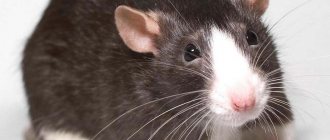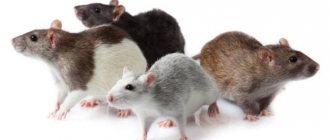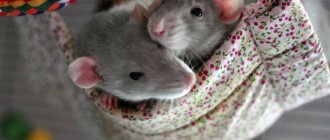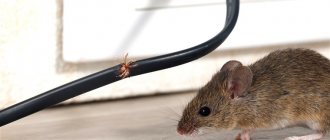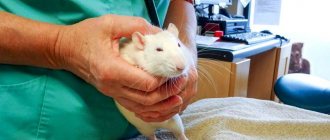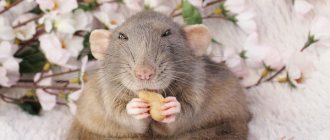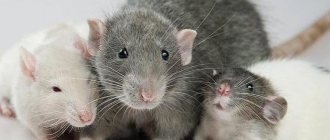How to determine the sex of a decorative rat. What are the differences between females and males. The main differences are in the appearance of decorative rodents. Are there any differences in the behavior and character of the pets? Where is the best place to buy an animal? What you need to know about maintenance and care. Tips and recommendations for owners.
When we want to buy a decorative rat, we try to think through everything down to the smallest detail, where the pet will live, what items it will need, what to name it, how to feed it properly. In addition, everyone has their own preferences regarding the breed and gender of the animal.
After all, females and males differ in character and behavior. In addition, there are many situations when it may be necessary to understand and determine the sex of an animal. Next, we will take a closer look at how to determine the sex of a rat and learn about all the differences and characteristics of boys and girls.
What are the differences between the sexes?
So, the most important difference between an adult male and a female is, of course, the presence of testicles. They are located directly under the animal's tail. They are easy enough to see, but can also be felt with your finger.
But it should be remembered that if you lift the tail, they move inside the tummy and it becomes very difficult to notice them externally; they can also move at low temperatures. Therefore, in such cases, you can easily confuse the gender. During inspection, the tail should not be raised; it should be kept down.
Females have mammary glands, which are located in 2 rows; in boys, they do not appear at all. There is also a difference in the distance between the anus and the urethra. If in girls they are located close to each other and are at a distance of 2-3 mm, then in boys this distance is 5-6 mm.
Remember that when examining a pet, you should not squeeze it tightly, hold it by the tail, or make sudden movements. They are very shy and this can cause stress. Hold it carefully, you can try placing it on your palm with its back. The differences apply to all breeds, Dumbo and others. Photos will help with the correct definition.
Nicknames by color
The coloring of Dumbo rats is varied. There are gray ones, similar to ordinary barn rats, as well as black, red, white and spotted specimens.
Here are the nicknames based on fur color:
- Chernoukh;
- Ryzhik;
- Redhead;
- Belyak;
- Belyanochka;
- Grey;
- Snowball;
- Chernyavka;
- Chernysh;
- Sergul;
- Frost;
- Snowball;
- Marshmallow;
- Ed;
- Snezhana;
- Squirrel;
- Ogonyok;
- Ember;
- Crystal;
- Chanterelle;
- Medyanik;
- Serco;
- Serebrul;
- Swarthy;
- Squirrel;
- Speck;
- Leopardik.
Chernysh
How to choose a pet?
First of all, it should be said that the place where the animal is purchased is very important. It is not recommended to purchase a rodent by hand if there is no way to check the conditions in which it is kept. Because there is a high probability that a sick or old animal may be sold to you.
It is better to buy a rat from trusted breeders or from a pet store. Breeders, as a rule, pay great attention to proper maintenance, care and feeding. They can tell you about the rat’s parents, characteristics of the breed, character, behavior, and give recommendations regarding further maintenance.
It is necessary to examine the animal; a healthy individual always has very beautiful and shiny fur, without any bald spots. The ears and eyes must be clean and free of any discharge. If there are other rodents in the cage, pay attention to them; they should also have a healthy appearance.
Animals should be active and mobile; if they are very calm, sit in one place and do not react to humans, this may indicate illness. Also, you should not choose highly excited individuals. On average, decorative pet rats live 2-2.5 years, but this period can be increased if the animal is provided with proper care and adequate nutrition.
How else can you tell the difference between a female and a male? Indirect signs
In addition to differences in reproductive organs, male and female rats typically differ in body size and type, behavior, smell, and other factors.
In general, males are larger, wider and heavier, with thicker tails and coarser coats. They have broad heads and shoulders that have a “brick” shape.
Females are more graceful, meaning they have a narrower, more streamlined shape with shorter, shinier coats. They are usually smaller and lighter, but a small boy can be significantly smaller than a large girl.
However, some pet rats can weigh even more than this.
Most female rats prefer to move around a lot rather than sit still, but not all male rats share this trait.
Male rats can certainly be calm and relaxed, but that doesn't make them lazy. Almost all rats, given a lot of attention from birth, will enjoy time with their people and the touch we often want to share with them.
Women's hormonal cycles can sometimes affect their behavior, making them more restless and even irritable. However, many females show almost no signs of estrus and yet remain alert.
Menopause in females occurs between 15 and 18 months, although some females remain fertile into old age. Males are capable of constantly reproducing offspring until old age. They do not have a reproductive cycle, but their testosterone levels fluctuate greatly.
Sex hormones are also associated with the slightly musky odor that many males have (not heavy or unpleasant). People often describe their female rats as smelling like grapes, perfume, or even popcorn. This is the smell of the rats themselves, not their cage - most likely it is the smell of urine or feces.
We believe that all rats make wonderful pets, regardless of whether they are male or female. However, most people will develop a strong preference for one gender over the other, and this is completely normal.
We humans are individuals too, and we all look for different traits and characteristics in the animals we choose as pets. So, regardless of gender, your rats can be active, interesting and affectionate companions.
Source
Sex determination in small rodents
First of all, it should be noted that the first sexual differences in small animals appear on the 4th-5th day of life. The task of identification will be facilitated by the fact that animals at this age do not have fur, so just look at the tummy. Girls will have noticeable small nipples, they are arranged in two rows. In boys, they are absent throughout their lives.
You can also pay attention to the skin between the anus and urethra. If small dark spots are observed, this is a male specimen. Such spots are future testicles; they are not yet visible because they are in the process of formation.
Creative English nicknames
English names are also at the peak of popularity. They are always in fashion. Both classic and extraordinary.
An interesting selection of creative names for Dumbo rats:
- Slang;
- Respect;
- Like;
- Dig;
- Little;
- Follower;
- Burger;
- Dir;
- Fluffy;
- Slot;
- Prank;
- National;
- Job;
- Stroppy;
- Proof;
- Chica;
- Dodge;
- Let's Go;
- Agri;
- Bestie;
- Crush;
- Rofl;
- Skill;
- Stream;
- Fakap;
- Mate.
Differences in appearance and personality
In addition to physiological ones, there are differences in the behavior and character of the animals. In addition, you can find differences in the external characteristics of pets.
Let's look at them in more detail:
- Boys are always larger than girls, they have a stronger and more powerful physique, but it will be difficult to notice this at an early age.
- Girls boast very graceful body shapes, while boys have a pear-shaped body.
- There are also differences in the coat; in males the fur is quite dense and hard, while in females it is very soft, smooth and silky.
- Females are very inquisitive, they are interested in everything and want to examine all the objects around them, in addition, they are very willing to try them out. But males, on the contrary, spend more time in peace, like to hide in a house, and also don’t mind sleeping more.
- No matter how strange it may sound, females are more aggressive than males. This is not due to a difficult character or complex disposition. It is their nature to protect their offspring, so when frightened they are capable of scratching and even biting.
- Males have a stronger smell of urine, but if you keep your pets properly and carry out regular cleaning, this is not so noticeable.\
Experienced breeders recommend purchasing two animals at once, especially in cases where the owners do not have enough free time. This will prevent the animals from getting bored, and they have a very hard time withstanding loneliness.
But to keep two rodents in one cage, it is necessary to purchase girls. They get along well with each other, while males can fight over food and territory.
Before buying a pet, it is important to weigh all the advantages and disadvantages so that there are no difficulties later.
Rat boy or rat girl - that is the question!
Now, you have decided for yourself that you want to get a pet like a rat!
First of all, congratulations! This is a great solution!
But the question is, who should you choose? If the choice of the color and even the “breed” of a little rat is a secondary matter, because we still choose a pet more with our hearts than with our eyes, then deciding on the gender of the future pet is a very pressing question!
The choice of sex of the little rat will determine what character and even appearance it will have in the future. The main difference is the activity of the future
pet. If at a young age almost all animals have a playful disposition, then as they grow up, other character traits are assigned to them.
Boys
As a rule,
they become lazy couch potatoes
and it is very important for them
to follow a diet
, because a lazy lifestyle can lead to the animal becoming fat.
Boys live well alone
, but you need to understand that in this case you must give the animal a lot of free time so that it does not get bored or sad without the attention of its owner.
But mating a boy with another boy
can turn out to be dangerous
in the future - such couples
often have clashes for “superiority”
in the pack.
Although, there are also many cases of ideal cohabitation. But if you decide to get a rat for the first time, it’s better not to risk it. The boy of rats is the ideal companion for someone who loves to spend evenings in a chair reading a book or TV series.
He will sit comfortably in your arms or on your legs for scratching his chubby belly :).
In size, an adult male is much larger and heavier than a female with quite impressive “wealth” under his tail). On the downside
, boys need much more careful hygienic care, and despite the fact that rats themselves, in principle, do not have a particularly unpleasant odor, boys are still boys and no one has canceled the habit of marking their territory.
Article on the topic: How much does a domestic decorative rat cost in a pet store, nursery and on the market?
Girls
They remain very active
until old age They are extremely inquisitive and playful throughout their lives.
Unlike boys, girls can and SHOULD be kept in pairs.
I would say that they
should only be kept in pairs
, because they are
extremely sociable
creatures, and if in the case of guys, the lack of a friend is compensated by the increased attention of the owner, then this will not be enough for girls.
Experience has shown that keeping two
rather than one rat
has no effect
on financial costs or the cleanliness of the cage.
No matter how illogical it may sound! Keeping two rats brings many new moments into their life and yours, from playing in a cage with each other, ending with a funny fight for the owner’s attention, slight jealousy and a very sweet reconciliation after in the form of “combing” each other and sleeping almost in an embrace) . Ideally, take two rats in one place,
since they are already accustomed to each other.
Females grow smaller
in size than , and if guys’ fur becomes hard with age,
girls’ fur always remains soft
, and with proper care, silky).
On the downside
, the most common disease among female rats is
mammary gland tumor
.
But don't be afraid of this!
The first time you notice any swelling,
go to the vet.
It is
easy to operate
; we had a girl who was unlucky and during her life she underwent 6(.) operations to remove such tumors. And she lived with us for more than three and a half years.
Important content points
If the owner devotes time to proper maintenance, care and nutrition, he will prolong the life of his pet. It is necessary to properly arrange the animal's cage, equip it with shelves, ladders, tunnels, hammocks, and houses.
Physical activity is very important for a rat's health. In addition, remember that these rodents are social animals and need care and attention.
Be sure to regularly clean the cage, monitor the condition of the claws, teeth, ears, and tail. They are very clean animals and do not need help from people, but sometimes it may be required.
Examine the animal and monitor its well-being. If you notice changes in behavior, loss of appetite, discharge from the nose, eyes, or any other symptoms that look different than usual, contact your doctor immediately. All diseases are treatable if they are diagnosed in the early stages.
What kind of domestic rodents exist: list of species, how long do they live at home?
Pet rodents
Pet rodents are deservedly popular. Small furry animals are funny, cute and relatively unpretentious - they are easier and more economical to keep than a cat or dog. There are several types of rodents that are suitable for living at home. Here is the list:
- Common hamsters
- Djungarian hamsters
- Guinea pigs
- Decorative rabbits
- Chinchillas
- Gerbils
- Rats, etc.
Decorative rats occupy not the last place among pet rodents. They are distinguished by intelligence, affection and learning ability, as well as greater cleanliness than is commonly thought.
Difficulties in keeping rodents can arise due to their need to sharpen their teeth. Rodents are rodents: they love to taste everything, even wires. Disadvantages include the low life expectancy of animals at home. If guinea pigs can live 6-8 years , then rabbits and chinchillas can up to 15 years . The lifespan of other small rodents is about 3 years . This also applies to decorative rats. When choosing a pet (especially for a child), you need to keep this in mind to avoid future stress.
When to transplant young animals
The development of baby rats occurs rapidly. At the age of 25 days, it is already possible to place the male rats separately from the girls. This recommendation applies more to males, as they can mate with sisters or their mother. After about a month, it is advisable to seat the males, otherwise they will start fighting with each other.
The young animals are provided with fully equipped cages, the same as those for adult rats. Each animal should have its own resting house. To increase physical activity, a running wheel, ladders and tunnels are placed inside.
The diet of the younger generation must include fresh greens, wheat sprouts, as well as animal foods, which contain a lot of protein. 1-2 times a week, rat pups are given fish oil.
At 5-6 weeks, the rats can be given to new owners. You shouldn’t delay this, because the younger the pet, the easier it will tolerate a change of environment.
Features of birth
After the baby is 3–3.5 weeks old, the owner can pick him up. Rodent breeders note that the more often you hold them in your arms, the more affectionate and obedient they will become. The key is to not overdo it. You need to know when to stop everything. Excessive affection is a factor in the development of stress in a pet. You should not separate the mother from the babies for a month. The immune system of newborn rat pups is directly dependent on how long they will be around it.
The total growth period for rat pups is one year. As for nutritional features, after a month you can add cottage cheese, boiled chicken bones, apples, milk corn, and bananas to their diet. There are also a number of foods that should not be included in the diet of baby rats. These are yolk, broccoli, salads, cucumber, liver, tomatoes.
Experts in breeding animals of the rodent family advise adhering to the above recommendations at least until the baby rats reach three months.
The small animal is a defenseless creature that needs special careful care and maternal attention. The attitude of owners towards an animal should be the same as towards their child.
Names for two rats
If two Dumbo rats appear in the house at once, you can give them interesting paired nicknames.
For boy and girl:
- Misha and Masha;
- Dandy and Mendy;
- Demi and Sam;
- Sima and Tim;
- Moscow and St. Petersburg;
- Ryan and Ariana;
- Alyonushka and Ivanushka;
- Kayi Gerda;
- Odysseus and Penelope;
- Annie and Zhenek;
- Bonnie and Clyde;
- Rozzi - Deddy;
- Yin and Yang;
- Pear and Grisha.
Romeo and Juliet
For two boys:
- East and West;
- Sherlock and Watson;
- Bruce and Barney;
- Venya and Senya;
- Chip and Dale;
- Kor and Thor;
- Carrie - Parry;
- Cheese and Fat;
- Lord and Record;
- Old and Dod;
- Cube and Rubik;
- Gustav and Rostislav;
- Pound and Sterling;
- Boris and Storis.
For the female spirits of Dumbo:
- Olesya and Alisa;
- Cleopatra and Nefertiti;
- Pizza and Nice;
- Ricotta and Aletta;
- Belyanochka and Rosette;
- Zita and Gita;
- Krysyamba and Masyamba.

